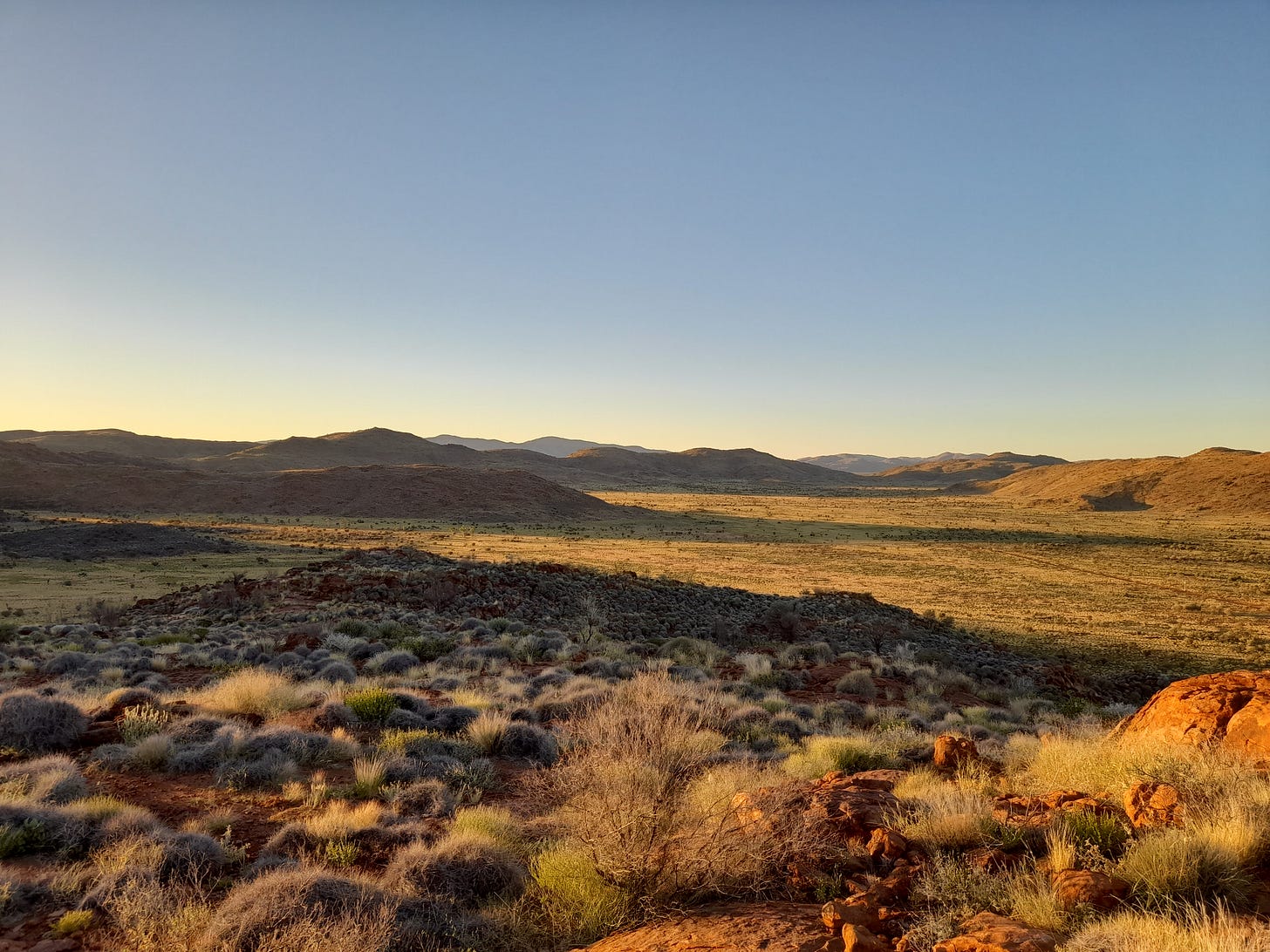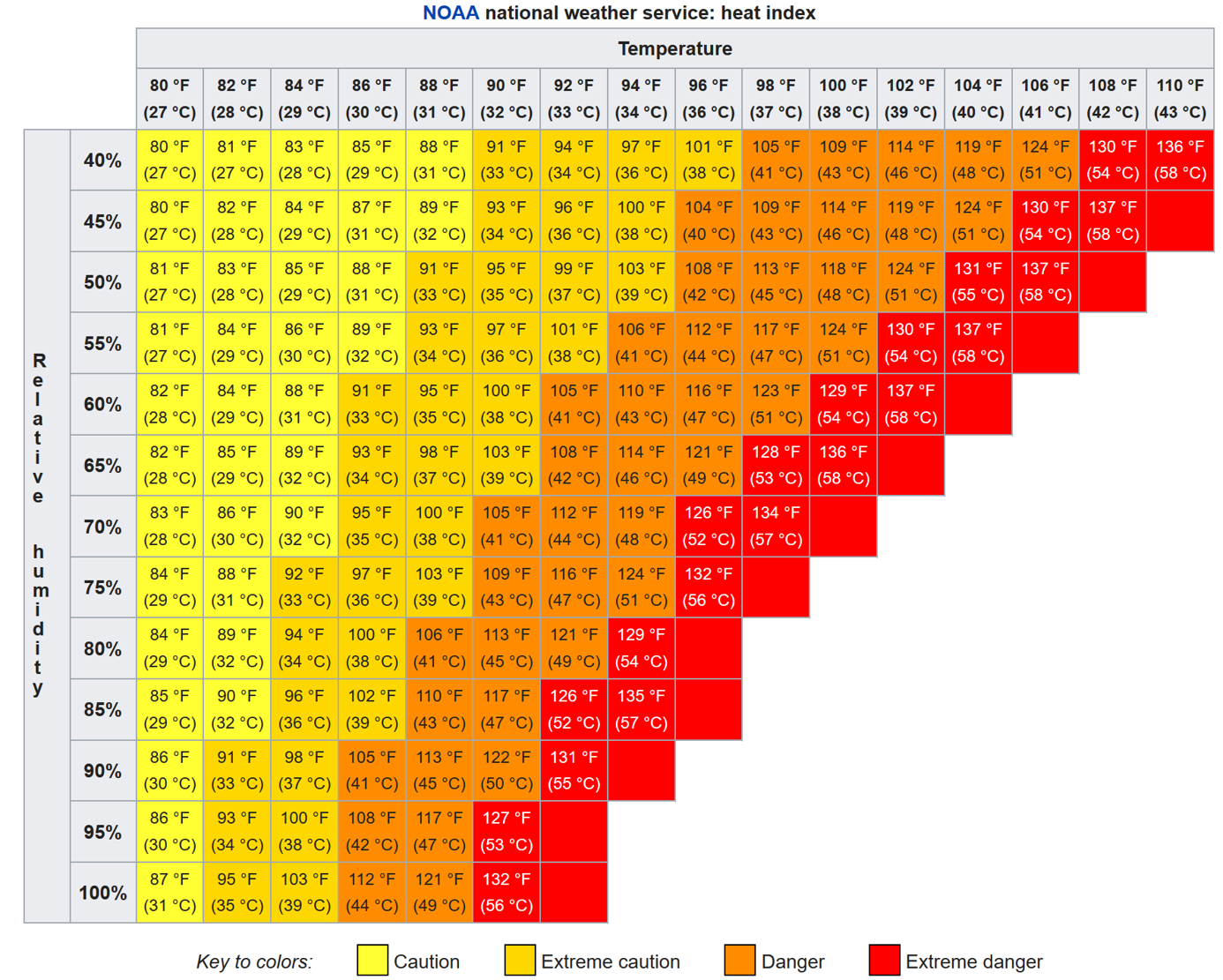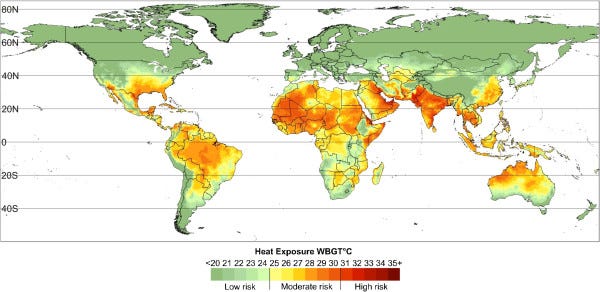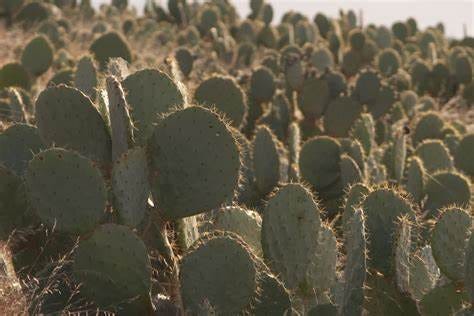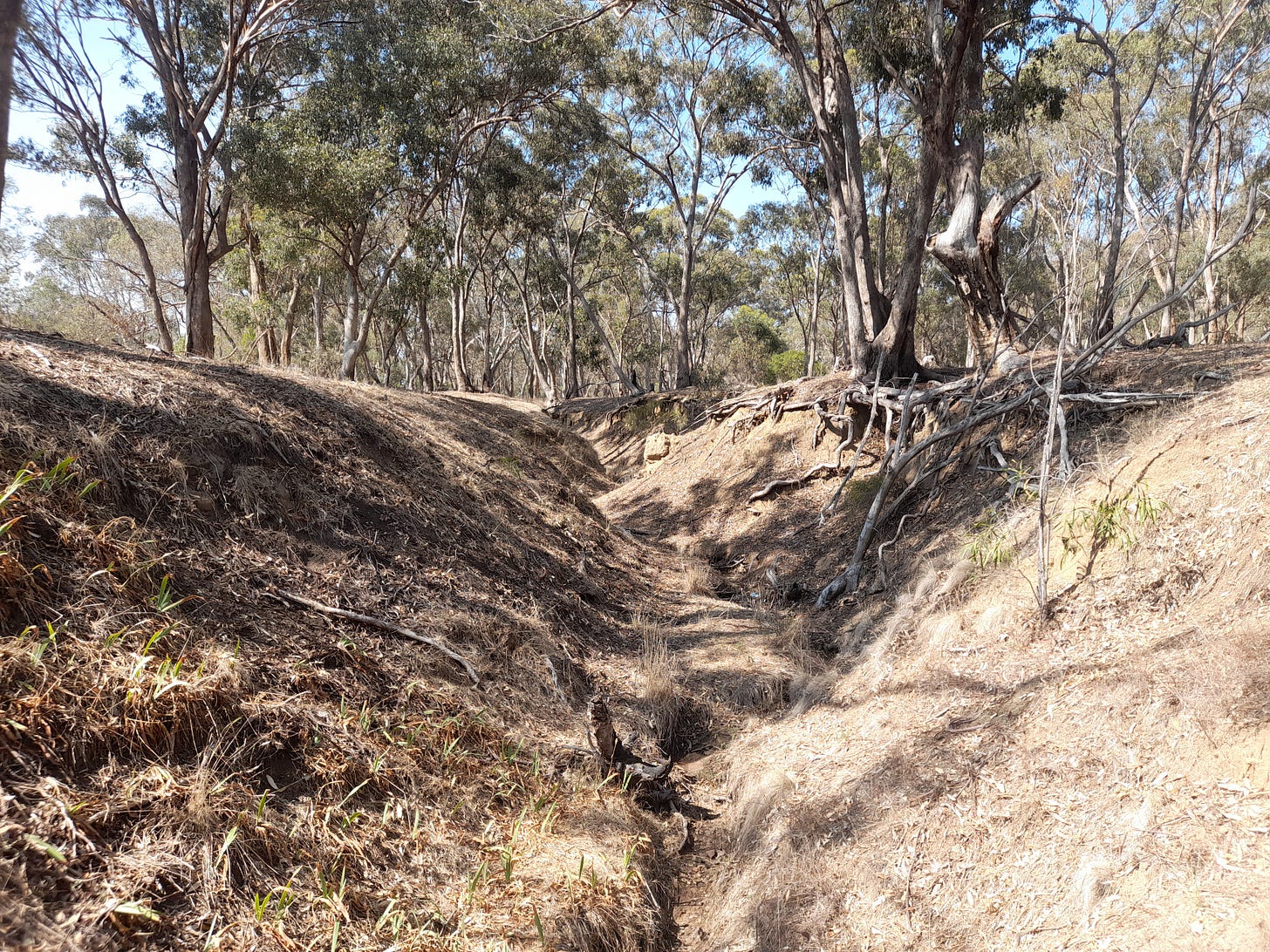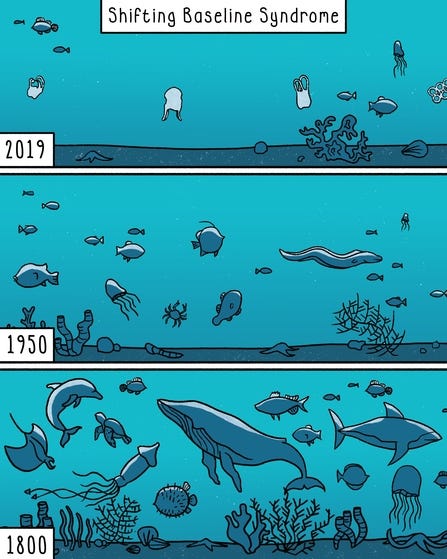This is not a particularly literary piece. Having written After the Gold Rush (which I strongly suggest you read before you dive in here), I felt that I had made some ‘predictions’ that might seem a bit wild to some readers. Of course, I could be wrong, and perhaps I hope that I am. But these predictions (they feel a bit more like visions) draw on a lot of experience and knowledge gained across Africa and desert Australia and as a farmer in central Victoria. They are not as wild as they might seem. Do, please, read After the Gold Rush first if you have not already. Otherwise what follows might not make very much sense. Here it is.
**Audio Version**
Sometimes the idea that sparks a story has unexpected impacts on the way the story is told and the ‘facts’ that can be carried through it. In the case of ‘After the Gold Rush’, this was certainly the case.
I have spent a good part of my life in the central deserts of Australia, and a good part of that time with Pitjantjatjara people. I became acutely aware that a major ‘moment’ was approaching as the few people who had walked the land and lived a traditional hunter-gatherer lifestyle, and for whom the metaphysics of the Dreaming were primal, were growing older and one by one, ‘falling off the twig’. One day, it will be the last. For the Pitjantjatjara themselves, this moment may not be particularly significant - the loss of any person is a deeply felt tragedy. For me though, it seems a symbolic moment in which the crushing realities of colonisation will be rendered irreversible. A whole way of life, a way of life that was whole, a whole praxis that shaped that unique environment and the people themselves would be lost in that moment. The reality of course is that for the people it has been a matter of adaptation: a traumatic melding, on unequal terms of two utterly different visions and ways of being in the world. For the environment it has been a death-by-a-thousand-cuts. First with the encroachment of feral animals – cats, foxes and rabbits that decimated the spectrum of fauna that used to inhabit those lands, then the loss of traditional burning practices that decimated the vegetation, and finally the arrival of noxious weeds – most catastrophically buffel grass (Cenchrus ciliaris) that will change the landscape utterly.
I did not set out here to write anthropology, but I hope you can feel the resonance of the idea that my own culture will face its own ‘moment’ in the not-too-distant-future. In some ways it is a relief: the end to a culture that has pillaged the planet, destroyed entire ways of life and in Josh Shrei’s memorable words “Destroyed the world. For what? For shopping malls?” Perhaps you can feel the added poignancy if at least some of those people have belatedly done the right thing? I have a troubled relationship with my ancestors. They played some part in bringing us to this juncture. But really, we got here by accident. Not many people in any age have set out to destroy the world. They just make what seem like sensible decisions at the time, using the knowledge and prevailing attitudes of the time. It probably all seemed so exciting. The conquest of distant lands, shaking off the vulnerability of landlessness, the gold rush, the internal combustion engine. One’s own house. Jumbo jets. Colonising Mars. Exciting. As Tyson Yungkaporta points out: ours is an adolescent culture.
So, after a lot of explanation, that is why I started as I did, to capture that moment, when one world passes and another walks on alone. I wrote almost in ‘download’ mode – with words pouring out onto the keyboard – I was aware of a lot of ‘problems’, mainly of a temporal nature, as I wrote. I went back later and fixed a lot of them, added a few more and tried to just make it all work without killing off any magic that might have survived its passage through me. Here I want to expand further on some of the ideas. For two reasons. Firstly, I don’t think very many people understand just how dire the situation is, and that we would all be much freer to act appropriately if we knew; and secondly, to show that even though our love for shopping malls has stolen a lot from future generations, there are still things we can do to ease their way. Things we must do if they are not to despise us.
I have little doubt that southern Australia will suffer conditions as depicted, but I don’t think it will be quite so bad by 2125. It will probably take a further 50 years – but who knows? The ‘best’ climate models are having to run fast to keep up with events these days.
Agricultural Collapse
I do think that catastrophic famine events will occur within the next two decades. See That Old Horseman Again for more detail. The primary driver will be erratic weather occurring across multiple breadbasket regions. Episodes of drought, flood, extreme heat or extreme frost/cold can destroy staple crops. If this happens across too much of the world too often, then food reserves will be depleted, and prices will rise beyond the reach of the 30% of the world’s population who are already food insecure. Other potential factors of significance include conflict, economic shocks, the depletion of fossil fuels necessary for traction and fertiliser production, and novel diseases. There are 8 billion people and a fragile food supply governed by the wrong people and pursuing the wrong objectives. What’s to go wrong?
Deadly Humid Heat (High heat index)
Similarly, I think it inevitable that ‘humid-heat’ events will cause unthinkable trauma in vulnerable regions. At humidity of 80%, in air temperatures above 35 degrees, the human body is unable to cool itself by sweating. Heat stroke and death occurs in 6 hours. If the humidity is 100% and the temperature 35 degrees, death comes in as little as 20 minutes
Such conditions are quite rare at present, but large parts of the world, home to well over a billion people are highly vulnerable: the sub-continent (Pakistan, India, Sri Lanka, Bangladesh and Burma), South-East Asia, Iran and Iraq, the Arabian Peninsula, parts of Mexico and Central America, the lowland Amazon region, parts of Northern Australia, West Africa and the Horn of Africa.
https://www.city-data.com/forum/weather/1391165-highest-wet-bulb-temperatures-around-world-3.html
When such conditions occur, it is the poorest people, living without air conditioning, and needing to work every day just to put food on the table who will die. It is also worth pointing out that is not the average that does the damage, but the anomaly - the one crazy hot day that falls at the far-right of the bell-curve. If extreme conditions persist for days or weeks, the thresholds for mass casualties become significantly lower as people become exhausted and coping systems are strained to breaking point.
Fire
It hardly seems necessary, given the Australian bushfires of 2019-20; the Canadian bushfires of 2024; the Amazon fires of 2024, and the Los Angeles fires of 2025 to suggest that fire is becoming a major shaping force in the world. Fire is also causing a massive rise in global atmospheric CO2 concentrations, wiping out all human attempts (such as they are) to reduce greenhouse gases. For a few years it has been argued that we are in the Anthropocene. I contend that we are, or will shortly be in the Pyrocene – when fire becomes the dominant force that shapes the world. This is not a happy thought.
In many parts of Australia it is becoming very difficult to insure houses. Worldwide the cost of insurance is rising and is expected to rise further as the industry tries to recoup estimated payouts of more than US$150 billion following the Los Angeles fires. In the future, many people will be unable to afford insurance, or it will simply be refused. Given the increasing risk profiles across a range of potential disasters (of which fire is just one), this is a recipe for the impoverishment of large sectors of the population who will be unable to rebuild. The flow-on social and economic impacts will be severe.
Increased frequency and/or severity of wildfire gradually (or quickly) kills trees, even species that are considered to be fire-adapted. This dynamic is well established in northern Australia, where large old trees are disappearing (due to the loss of traditional burning and the resultant hotter fires), species mix is changed, age profile is changed and eventually open forest is replaced with grassland. In ecological terms this is a state-change from complexity to simplicity and represents a significant loss of diversity and stability.
From the perspective of agriculture, grain crops can be burned, fodder crops can be burned. Tree crops can be burned or smoke affected: these are further pressures on farmers and on food security more generally.
There is no certainty that the world in 2125 will be as benign as I have depicted. But it’s bleak enough, so let’s just leave it there with regards to climate.
But the flowers were so pretty…
As I wrote After the Gold Rush, I was avoiding something very local, but very troubling, and that is Opuntia robusta, Wheel Cactus. My district is host to an infestation of this terrible invasive weed, native to Mexico. Wheel cactus was brought to Australia as a garden plant – it has nice yellow flowers, attractive and (sort-of) edible red fruits, and grows on almost no water. Wheel cactus has escaped captivity, and now infests areas of southern Australia, including my patch. Wheel cactus grows large and forms a dense spiny mass that is virtually impenetrable to humans and kangaroos alike.
Wheel cactus in my district is currently partially controlled by a community group, the Tarrengower Cactus Control Group, with some half-hearted and intermittent assistance from the Victorian Government. Control is possible using chemicals – glysophate or daconate – or huge amounts of labour. (Please don’t think I love chemical controls. I dislike them intensely, but they are sometimes a necessary evil). Opuntia robusta is an infestation that, even with robust control efforts, will be present for generations, since the seed can persist in the soil for at least 20 years.
In a climate change world, in a world where everything that we take for granted – like chemical industries – becomes wobbly; when centralised governance becomes wobbly, what happens to weeds like wheel cactus? What happens is that they take over and thrive and displace all mammals larger than a rabbit.
The people in my story might benefit seasonally from the cactus fruits, nasty spiny things that they are, but they will lose access to huge areas of land, and any attempt to control the pest will be way beyond their capacity. The vaguely liveable world we might want to bequeath would be utterly undone by something like wheel cactus. Yet we cannot eradicate it even now, with all the human and technological resources we can bring to bear.
This is just my local situation (and it’s not the only invasive weed), but there is hardly a place on earth that would not have to deal with some exotic pest, that might well be beyond the capacity of a small, struggling community. What weeds will plague your descendants? Or invasive, exotic animals? In 2001, a colony of fire ants, native to South America were discovered in Queensland. These pests are a huge threat to agriculture, wildlife and humans and will be quite at home across most of the Australian continent. Yet the fire ant ‘footprint’ continues to grow in Queensland and Northern New South Wales despite government-led efforts at eradication (which only gets harder and more expensive as time passes). As with weeds such as Opuntia, the only viable control method is chemical. And don’t forget the (perhaps) even bigger risks that Jem Bendell pointed out, in the 440 nuclear reactors around the world that can only be kept safe in the longer term by a highly educated, energy rich and stable society - the type of society that we can no longer take for granted.
What is a good ancestor to do? Should we throw everything at getting rid of these time-bombs (weeds and reactors alike) whilst we still can? Or do we just shrug and add it to the can of calamities we are already kicking down the road?
Leaky weirs and water tables
I live in a gold rush region. In 1852, gold was ‘discovered’ in Victoria, and very soon the area was overrun with people out to win their fortune. In the early part of that period, the gold was found in watercourses and these were dug up, sifted and sluiced to obtain the alluvial gold that had sunk to the bedrock below. The overburden, sands and gravels of the creeks, now loosened, were quickly washed away downstream. Thousands of kilometres of stream were disturbed in this way, and most became deep, sheer-sided gullies. As the gully bottom disappeared downwards, so too did the watertable. In a healthy system, the alluvial sediments of floodplains act as giant sponges, filling with water in times of high stream flow, and releasing it slowly when the streamflow is lower. Meanwhile, that water store supports huge riparian trees that in turn support myriad other creatures, insects, arachnids, bird and mammals. Where the stream base is deeply cut, the water is not held in the alluvium, but flows quickly away, leaving the landscape desiccated and unproductive.
In North America and in Europe until the 16th Century, beavers have been amazing ‘ecosystem engineers’. The dams for which they are famous obstruct streams, slowing flow and creating a weir-pool that becomes a wetland, sequestering vast amounts of carbon and generating huge ecosystem diversity and thriving. Stream erosion is reduced, and water quality is improved.
Though Australia does not have, and never had beavers, we can emulate their effect by building ‘leaky weirs’ in strategic places along our streams from rocks, logs and broken branches. Just as with beavers, these weirs slow the water flow and give it time to be absorbed by the alluvium. The work of the Mulloon Institute shows that building a series of such structures on a ‘dry’ creek can, in only a few years create a perennially flowing stream. The Mulloon Institute’s work has been mainly in areas where streams have been degraded by agriculture and grazing. The problem probably exists to a degree anywhere on Earth where water flows, even ephemerally (unless there are beavers). In the goldfields, the issues are the same, but very much more severe, and the work will be harder. But it would be worth it. In the ‘old days’, our rivers featured large, deep pools that supported enormous murray cod. The trees that lined the rivers would have teemed with possums and birds. Those deep pools are mostly gone, filled with sediment released by gold mining and direct dredging of the river beds.
If I wanted to be a ‘good ancestor’, the reclaiming of these streams would be high on the list. We expect the environment will be hotter, perhaps with more rainfall, but that rain will fall in more intense events. Evaporation will be higher. It is critical then that water is retained in the landscape, preferably in the soil where evaporation is slower. If the streams and soils can be made healthy again, the land will support more biodiversity and be easier to live in, in almost every respect and for every creature.
Food and livelihoods
As I said above, I wrote After the Gold Rush almost as a ‘download’ from the ether. I did not think much at the time about the likelihood of this-or-that scenario. On reflection, I think that the vision I wrote of probably belongs more to 2225 than 2125, but that is immaterial. I am ancestor equally to whoever is alive at that time too. And if you alive, you need a livelihood. But what could we expect given the uncertainty of our future?
The degradation of land that has already occurred through business-as-usual agriculture and in some places, mining, renders the land much less productive than it once was. Soils are depleted or collapsed, biodiversity is a fraction of what it once was. Energy and resource flows through the system have been disrupted or hijacked to maximise short term profits in a system that has been built on the mantra : “Get big, or get out”, which in practice has meant, “Get a big debt, and chase big productivity to service that debt”. Add whatever the changing climate throws at us: probably higher average temperatures; higher evaporation rates; more extreme weather events; and less stability in seasonal rainfall patterns; maybe more or deeper droughts, and we can quickly see that life is going to be hard. Of course, that is absolutely the premise of After the Gold Rush. In the story, the loss of climatic stability has caused the collapse of civilisation. That may or may not happen. But I know what I would bet on, and anyway, ‘civilisation’ in one hundred years will be vastly different to anything we of today know, not only because of ‘natural change’, or ‘progress’, but because the resource base our industrial civilisation requires is depleting rapidly.
Agriculture will still be possible, but it will be much more precarious than it is for most farmers now. Ordinary farming in southern Australia may become more like farming in the Sahel region of Africa – where crops fail two years in five due to drought or other ‘shocks’. But farming will also become more difficult because the fossil fuel era will be over, and that does not just mean the end of vast traction power, but also the end of artificial nitrogenous fertilisers, of reliable global supply chains, and of markets beyond the local.
Humans have found the food they needed these three hundred thousand-odd years through various strategies: scavenging, hunting and gathering, pastoralism, agriculture and wage labouring so that we can go, um, shopping. Often we have used more than one strategy at a time – and please don’t make the mistake of seeing these strategies in some sort of hierarchy of development or worth. After all, here is me, sort of post-industrial, PhD holding, goat milking and garlic-growing, and I know people who scavenge the odd road kill kangaroo. (Apparently they are delicious). A proper ‘third world livelihood strategy’! And I am in awe of anyone who could make a good life hunting and gathering for a livelihood, or subsistence farming for a livelihood in some of the places I have spent time.
And in this future we are trying to skry out? We will hunt. We will gather. We will keep livestock. We will farm. And maybe we will sell our labour sometimes. From what I have learned in my times living in or visiting some of the toughest human-inhabited environments on earth, I can say this:
Hunting yields protein. It demands high levels of fitness and mobility, but also tends to build these in the hunters. It requires skills of the highest level. It requires a deep knowledge of both landscape and quarry: a connectedness, fierce concentration and vivacity. It requires, if it is to be successful over the longer term, a degree of restraint and governance across contiguous areas. The resource must be able to replenish faster than we take.
Gathering similarly requires and makes fitness and mobility. It too involves knowing the land intimately. Knowing what can be found where and when. Gathering can be important in delivering all parts of a diet, but particularly the micro-nutrients. For the Pitjantjatjara, gathering provided the ‘bread and butter’. The kangaroos and emus were the cream.
Keeping livestock - particularly goats and camels – is for many in marginal ecological areas the difference between sufficiency and malnutrition, particularly for children. A child whose family has a milch goat is far more likely to grow and develop along species-normal curves than one whose family does not. Livestock can turn very poor vegetable matter into high quality food – meat and milk. In Goatwalking: A Guide to Wildland Living and a Quest for the Peaceable Kingdom, Jim Corbett tells us that, with the exception of vitamin C and a few micronutrients, a human can obtain all of their nutrition from the milk of two goats. (See this under-read piece of mine). In harness, animals such as horses, camels and oxen can pull farm equipment and move products moderate distances to markets – as they do in much of Africa and Asia today.
Livestock require very particular and careful management. In a world without a steel industry that can produce wire, any fencing in a hundred years will be very much legacy and increasingly unreliable. In any case, in low-productivity or stochastic environments, livestock are better managed extensively by herders, rather than being contained in fenced areas (this approach is simply an artefact of the appropriation of the commons that started all this shit). Open range herds can be guided to the best feed, and moved on before they are able to do serious damage to the resource (as is done in large parts of Africa and Asia today). As with hunting, governance is required to avoid the risk of destructive overgrazing that will ultimately impact everyone negatively. How that governance is achieved in a world of civilisational collapse is a hot question, but it must, and will be answered.
Agriculture
In the world we are imagining, agriculture will be unreliable. The technology and energy to lift water from rivers or deep boreholes will be very limited. The lucky few will have access to a spring. Water can be pulled from shallow wells by hand or with simple pumps, though the available volume and quality can vary widely. Some storage of harvested rainwater is possible, but this is only going to be enough for highly efficient production systems such as wicking beds, and for high intensity production such as vegetables. Everything else will have to rely on the rain that falls from the sky.
Grain crops vary widely in their water needs. Maize and rice need vast quantities. Wheat is moderate. Barley needs least of all the old world grains. Some native grains may have potential – Erogrostis eriopida, from central Australia, a relative of the Ethiopian staple Teff springs to mind.
Tree crops should form the basis of any system, producing fruits and nuts, proteins, carbohydrates and vitamins. Trees also create microclimates that can support an understory of other productive species. Most trees will not produce a crop in years of drought, but they will generally survive, and produce the next year. The many species that can be selected, in the case of nuts for example, spreads the potential of a big yield of chestnuts in a good year, to a small, but reliable harvest of pistachios in a bad year. Something, at least, to eat.
Permaculture offers an integrated design system that mimics natural ecosystem function to create stable and resilient productive landscapes. It is such systems, applied at the landscape scale that the ‘good ancestor’ would be planting now. This will usually involve some expensive earthworks creating swales for water infiltration and dams for storage, and the sheer number of trees needed and their protection and maintenace in their tender years will take a lot of money and labour. If our imagined descendants are to have any chance of living well, they will need access to mature, deeply rooted trees, the produce of which can be pressed for oil, or dried and stored away for the inevitable bad seasons.
Be the Change
The final critical element that we would want to leave behind as good ancestors, is cultural. A toxic mindset brought us to this predicament, and there will be no acceptable outcome unless that mindset is jettisoned, and soon. I wrote After the Gold Rush from the perspective of a human, understandably enough. But what I hope you picked up was that the survival of humans is not just dependent on the survival of other species, but the very worth of surviving is dependent on those species being around. Shifting baseline syndrome deludes us into thinking that the world has always been much as we have known it.
https://www.surreywildlifetrust.org/blog/ben-siggery/space4nature-whats-baseline-part-1
We who are alive now live in a world whose biota has been depleted by a full 90 percent in the past 400 years. Our world is already a wreck, and yet we think it normal. What will we leave for those who come after us? And yes, they will find a way to be happy, and I suppose that is a blessing. But it is in our hands to pass on at least the wreckage that we love. But maybe we’d prefer economic security and a comfortable retirement?
We need to send forward a culture that recognises that the fate of all things are linked. A culture that sees humanity, not as separate, but as integral. A culture that blesses people with responsibilities rather than rights. Your freedom, your individualism, your human exceptionalism, is poison. Plain and simple. I know that it has been inculcated in all of us rich folk all our lives, and as such, it feels normal, these ways of thinking sit deep in our being as basic assumptions from which we form our ideas of right and wrong, sensible and stupid. We, most of us don’t know any other way to be. When humans encounter hard times, they tend to double down on these deeply seated assumptions. Vote for economic growth. The forest trees voting for the axe because the handle is made of wood. Hard times are upon us, and we can expect (and observe) that noxious individualism will dominate now until it is burned out, along with much of our world. It is from this distressing place that we must find and hold a truth worth holding, and quietly, diligently and thoughtfully give back to the future some of what we have robbed from them.




